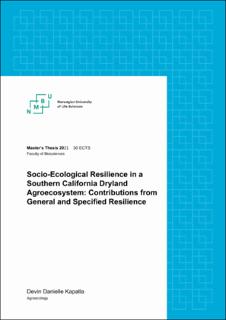| dc.contributor.advisor | Francis, Charles | |
| dc.contributor.advisor | Nicolaysen, Anna Marie | |
| dc.contributor.advisor | Kelly, Brenton | |
| dc.contributor.author | Kapalla, Devin Danielle | |
| dc.coverage.spatial | United States, California | en_US |
| dc.date.accessioned | 2021-09-01T13:15:59Z | |
| dc.date.available | 2021-09-01T13:15:59Z | |
| dc.date.issued | 2021 | |
| dc.identifier.uri | https://hdl.handle.net/11250/2772291 | |
| dc.description.abstract | In general, California agroecosystems are vulnerable to social and environmental change, threatening the provision of vital ecosystem services and human food security. Socio-ecological resilience, comprised of general resilience and specified resilience, could serve as a framework for improving the ability of agroecosystem managers in this region to support coping and adaptation to change. However, there are yet many examples of research into both general and specified resilience, particularly in this region. This research investigated the activities and methods employed in a Southern California dryland agroecosystem that contribute to these two resilience types. The researcher performed a case-study over five months in 2020 and used participatory observation and semi-structured interviews to identify activities and methods employed in the agroecosystem. The data were analyzed using two assessment frameworks, one for each resilience type. Through the data collection methods, 17 activities and 145 unique methods were identified. Through analysis, it was found that all 17 activities supported both resilience types and that 137 methods supported general resilience while 108 supported specified resilience. As these results suggest, it was discovered that many of the activities and methods support both resilience types. Some also supported multiple general resilience indicators and specified resilience main issues, indicating a high level of importance for overall resilience. However, difference between methods to support each of these resilience types were also discerned, upholding the need to consider both. The collection of these activities and methods support socio-ecological resilience through building overall resilience and facilitating adaptive capacity and agency, resulting in an example of a socio-ecologically resilient agroecosystem. Agroecosystem managers and policy makers can look to this example to build socio-ecological resilience in the California food system. | en_US |
| dc.language.iso | eng | en_US |
| dc.publisher | Norwegian University of Life Sciences, Ås | en_US |
| dc.rights | Attribution-NonCommercial-NoDerivatives 4.0 Internasjonal | * |
| dc.rights.uri | http://creativecommons.org/licenses/by-nc-nd/4.0/deed.no | * |
| dc.subject | Socio-ecological resilience | en_US |
| dc.subject | Agroecosystems | en_US |
| dc.subject | Socio-ecological systems | en_US |
| dc.subject | Adaptive capacity | en_US |
| dc.title | Socio-Ecological Resilience in a Southern California Dryland Agroecosystem: Contributions from General and Specified Resilience | en_US |
| dc.type | Master thesis | en_US |
| dc.subject.nsi | VDP::Agriculture and fishery disciplines: 900::Agriculture disciplines: 910::Management of natural resources: 914 | en_US |
| dc.subject.nsi | VDP::Agriculture and fishery disciplines: 900::Agriculture disciplines: 910::Other agricultural disciplines: 919 | en_US |
| dc.description.localcode | M-AE | en_US |

